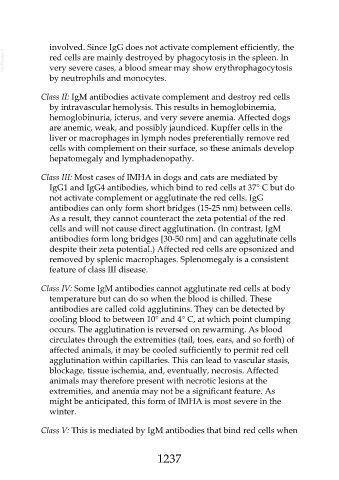Page 1237 - Veterinary Immunology, 10th Edition
P. 1237
involved. Since IgG does not activate complement efficiently, the
VetBooks.ir red cells are mainly destroyed by phagocytosis in the spleen. In
very severe cases, a blood smear may show erythrophagocytosis
by neutrophils and monocytes.
Class II: IgM antibodies activate complement and destroy red cells
by intravascular hemolysis. This results in hemoglobinemia,
hemoglobinuria, icterus, and very severe anemia. Affected dogs
are anemic, weak, and possibly jaundiced. Kupffer cells in the
liver or macrophages in lymph nodes preferentially remove red
cells with complement on their surface, so these animals develop
hepatomegaly and lymphadenopathy.
Class III: Most cases of IMHA in dogs and cats are mediated by
IgG1 and IgG4 antibodies, which bind to red cells at 37° C but do
not activate complement or agglutinate the red cells. IgG
antibodies can only form short bridges (15-25 nm) between cells.
As a result, they cannot counteract the zeta potential of the red
cells and will not cause direct agglutination. (In contrast, IgM
antibodies form long bridges [30-50 nm] and can agglutinate cells
despite their zeta potential.) Affected red cells are opsonized and
removed by splenic macrophages. Splenomegaly is a consistent
feature of class III disease.
Class IV: Some IgM antibodies cannot agglutinate red cells at body
temperature but can do so when the blood is chilled. These
antibodies are called cold agglutinins. They can be detected by
cooling blood to between 10° and 4° C, at which point clumping
occurs. The agglutination is reversed on rewarming. As blood
circulates through the extremities (tail, toes, ears, and so forth) of
affected animals, it may be cooled sufficiently to permit red cell
agglutination within capillaries. This can lead to vascular stasis,
blockage, tissue ischemia, and, eventually, necrosis. Affected
animals may therefore present with necrotic lesions at the
extremities, and anemia may not be a significant feature. As
might be anticipated, this form of IMHA is most severe in the
winter.
Class V: This is mediated by IgM antibodies that bind red cells when
1237

